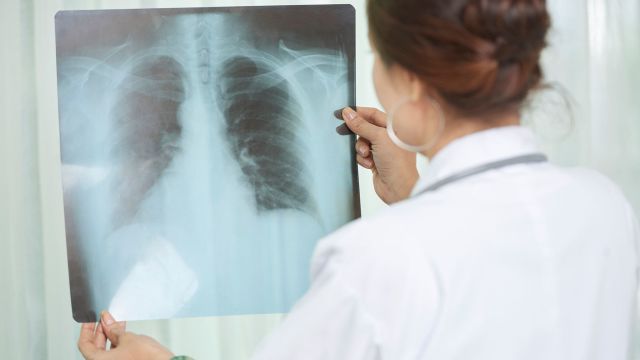There was a killer stalking the Brown family of Exeter, Rhode Island, in the late 19th century. After the deaths of a mother and two daughters, locals thought the culprit was clear—one of the deceased Browns was a vampire, and if they didn’t find out who, the lone remaining son, Edwin, would soon perish. To root out the vampire, townspeople exhumed the deceased Brown family members and declared the youngest daughter, Mercy, to be the perpetrator. Sadly, this revelation did nothing to help Edwin, who passed shortly thereafter.
This tragic family tale was one of the most sensational stories to come out of the New England Vampire Panic of the 19th century. The real killer throughout this era and beyond had nothing to do with the mythical undead, and was instead caused by a very real and still very deadly infection: tuberculosis.
Then known as consumption, tuberculosis (TB) isn’t just a threat from a bygone era. “It's still the leading infectious disease cause of death. It kills more people than AIDS, it kills more people than yellow fever or malaria across the world,” explains Elizabeth MacNeill, MD, chief of the Tuberculosis Control Branch for the Hawaii Department of Health (DOH).
According to estimates by the World Health Organization, one in four people around the world has TB and it kills around 1.6 million people annually. In the United States, the numbers are far less drastic. Nationally, there are 2.8 cases of TB per 100,000 people. Some states, however, have higher rates of infection, such as Alaska, Hawaii, Texas, New York and California. Immigration from parts of the world where TB is still common may be a reason why these states have more cases. In 2017, 70 percent of TB cases in the US were in foreign-born individuals.
How TB spreads
TB is a bacterial infection spread through the air from someone with an active infection to a non-infected person. Usually it infects the lungs causing a severe cough and possibly even coughing up blood. Casual contact such as shaking hands, or even sharing food or a toothbrush, will not spread the infection.
“The people at greatest risk of catching TB from a patient are those folks who are living with the TB patient. Then on average only about one in five will acquire the infection. Infectiousness varies quite a bit from patient to patient, and usually it takes close, prolonged contact with the TB patient to acquire the infection,” says Dr. MacNeill.
While the TB infection itself doesn’t discriminate, unfortunately minorities have disproportionately higher rates of the disease. Native Hawaiians and Pacific Islanders, Asians, Hispanics and Latinos and African Americans all have higher rates of TB disease than white Americans in the US.
Two types of infection
There are two types of TB infection: Latent TB infection (LTBI) and TB disease. People with LTBI have the TB bacteria living in their bodies but aren’t sick. They also aren’t contagious but usually will test positive for TB. They may or may not go on to develop TB disease. According to MacNeill, “nine out of ten people with latent TB will never get sick.” Some risk factors of LTBI developing into TB disease include age, HIV status, substance abuse, diabetes or other medical conditions that may weaken your immune system.
It’s impossible to say exactly how many cases of LTBI there are in the US today. Different factors can lead to a person developing TB disease from LTBI, including a weakened immune system. People with LTBI should consult with a doctor to go over possible risk factors of developing TB disease and treatment options.
TB disease is an active infection. People with TB disease are very sick and can pass the infection on. Some of the symptoms of TB disease include:
- Persistent cough that lasts more than three weeks
- Chest pain
- Coughing up blood or phlegm
- Fever
- Lack of appetite or weight loss
- Fatigue or weakness
- Chills
- Night sweats
It’s important to note though that not all cases of TB disease will affect the lungs. “TB can go to almost any place in your body: your eyes, your brain, your bones, your reproductive organs, your intestines, the sac around the heart,” says MacNeill. That means not all cases of TB will include a cough.
Testing, treatment and prevention
A vaccine is available for TB called Bacille Calmette-Guerin (BCG), but it is not always effective and generally not administered in the United States. In developing countries where TB is more common, infants and young children may receive BCG to ward off an infection.
There are two types of tests available to screen for TB—a skin test and a blood test. People who have received the BCG vaccination may have a false positive skin test and require further screening. There are two FDA-approved blood tests for TB in the US. People who have received the BCG vaccine or have had a positive skin test will likely have to get the blood test to confirm either LTBI or TB disease.
After a person has had a confirmed positive TB test, a doctor will evaluate them to see if they have LTBI or TB disease. Doctors will take a medical history, perform a medical exam, take a chest x-ray and may run additional lab tests to make an accurate diagnosis.
Treatment for TB disease can take six to nine months. People with TB disease will work with their doctors to determine the right combination of medications to treat the infection.
Not all cases of LTBI require treatment. Only 5 to 10 percent of people with LTBI will go on to develop TB disease, and a variety of risk factors can help physicians determine if someone with LTBI is likely to get TB disease. Risk factors can include age, HIV status, substance abuse, diabetes and medical conditions that weaken immune systems. Treatment for LTBI can be shorter than for TB disease at three or four months total. Treatment plans are determined by a physician on a case-by-case basis.
While TB remains a global threat, it is thankfully not the mysterious killer that once plagued the US, fueling superstition and fear. It has a name and treatment plan that will hopefully one day make TB something that truly is a bygone disease.






